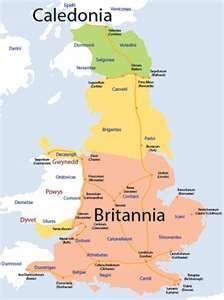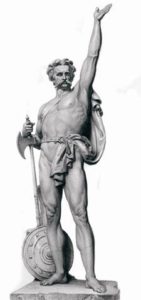Below is a detailed article about the Roman provinces in Britain. It was known as the Provincia Britannia. The Romans occupied Britain from 43 AD to 410 AD. In this time, they settled in Britain and occupied the lands. Let us see the different Roman provinces in Roman Britain.
Roman Britain in itself was a province. However, it was divided into categories for proper administration. They were tribal capitals that were also Celtic that existed in the time.
Administrative provinces of Roman Britain
Contents

The Atrebates
The Celtic word Atrebates literally means ‘inhabitants or ‘dwellers of a settlement’ as were the Atrebates. They occupied regions such as Sussex, Berkshire, and Hampshire during the Roman Britain Era. They were among the most powerful and brave tribes. During Julius Caesar’s invasion, there was a British commander of the tribe – Commius. His descendant fought against Caesar but failed. The conquest continued until the Claudian invasion.
The place where this tribe settled is today known as Silchester, England.
The Belgae
The Belgae were a Gallic – Germanic tribe that resided on the banks of the river Rhine. They were very large in number and occupied a large patch of land in England. The Romans came to this area around the year 150 AD. This was the tribe that invented the heavy plow that is a device used to even out the land for cultivation. They are known for this major invention throughout the world.
The areas they occupied are Colchester, St Albans and some parts of Silchester.
The Brigantes
This is a well-known tribe under Roman Britain. Originally, they were Celtic. They occupied the largest section of Northern England. They were worshippers of a pagan goddess called Brigantia. The administrative territory was referred to as Brigantia. It is now called Yorkshire. The tribe was also found in Ireland and occupied the areas of Wexford, Waterford, and Kilkenny.
The Brigantes Queen – Cartmandua was loyal to the Romans and handed over the defeated chief – Caracatus in the hands of the Romans. The Queen and her husband defended the Romans and had an agreement with them. During Roman times, the territories were called Epiacum, Vinovium, Cataractonium, Olicana, Eboracum.

The Carventi
The Carventi means ‘the people of the deer’ in the Celtic language. They got the name from their ability to hunt. In Roman times, the province occupied by them was called ‘Luguvalium Carvetiorum’. Today, these areas are Great Chester, Stanwix, Old Penrith, Ravenglass and Bowness on Solway.
The Catauvellauni
This tribe had a large population and occupied the southeastern part of Britain. It was a Celtic tribe and Catauvellauni means ‘the people that led in battle’ in the Celtic language. Ancient coins have been discovered by archaeologists that were used in the pre-Roman Britain era by the Catauvellauni tribe. This denoted their strong presence and an entire civilization that existed before the Romans entered.
They occupied the Roman province of Verlamion which today is St Albans, England. The man betrayed by the Queen of the Brigantes -Caracatus, was the chief of this tribe. Later, the Catauvellauni tribe were highly involved in the construction of Hadrian’s wall.
The Corieltauvi
The Corieltauvi was a tribe in Britain that settled in areas of the border of the area occupied by Brigantes tribe. The Roman Road – Fosse Way passed through their territory. They had very little or almost no resistance to the Roman Rule. They were also famously known as ‘Coritani’. They occupied the English East Midlands. Their capital was in the Leicester area. Many ancient gold and silver coins have been found in their territory.
They were found mostly in areas of Lincoln, Ancaster, Scunthorpe, East Stoke, and Littleborough.
The Demetae
The tribe was formed during the British Iron age. They were Celtic in nature and spoke the Celtic language. They were found in the areas of South West Wales. They inhabited in the coastal regions and were a Roman province during the Roman British era. Today, the areas are known as Pembrokeshire and Carmarthenshire in the Southwest of Wales. They worshipped the pagan god Demetos and hence were known as the Demetaes. Romans called this province Moridunum Demetarum.
The Iceni
This Celtic tribe gets its name from the Celtic word that means ‘the people of the pine trees’. They were formed in the British Iron Age. They occupied the areas of Norfolk, Cambridgeshire and some parts of Suffolk. In the Roman British period, their capital was Venta Icenorum which in Norfolk county. The place is recognized as British Roman territory or Roman Britain province and is a tourist attraction spot. Archaeological excavations show gold, silver and bronze coins used by the Iceni.
The Iceni was the tribe that caused the biggest revolt against the Roman army. They slaughtered and outnumbered most of the Roman soldiers during the battles. They were the strongest and highly armed group of men out of all the Celtic tribes. The famous story of Boudicca belonged to the Iceni tribe. The tribes were located in areas of Ixworth, Hockwold cum Wilton, Thetford, Snettisham, and Woodcock Hill.
Division of Provinces in 212 AD
In 212 AD, during the rule of Roman Emperor Caracalla, Roman Britain province was divided on the basis of political division. By this time, all the tribes had surrendered to the Romans and it was the second to third generation under the Roman rule. They all adapted to Roman ways and also adopted Christianity and gave off the pagan worship. The Romans were therefore smoothly governing all territories. Britain was divided into two parts – Britannia Superior and Britannia Inferior.

Britannia Superior
Britannia Superior was formed in 197 AD by Emperor Septimus Severus after winning a civil war. The capital of this territory was Londonium or present-day London. It was called ‘Superior’ only due to its closeness to the Roman capital – Rome. It comprised all of what is South England today.
Britannia Inferior
Britannia Inferior was formed in 197 AD – the same year the Britannia Superior was formed as a result of the reforms made by Septimus Severus the Roman Emperor. This comprised all of what comes under Northern England. It was named ‘Inferior’ only due to its long distance from the Roman capital of Rome. Hadrian’s Wall was in this territory which was a Roman Britain province. The capital of this territory was York.
